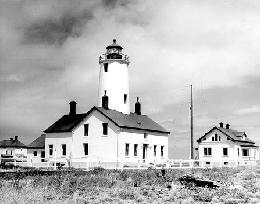by John Maxwell
For the Sequim Gazette
Editor’s note: This is the 11th in a monthly series about the Dungeness National Wildlife Refuge, past and present. — MD
The “Roaring Twenties” of the Prohibition Era was an exciting time: Flappers dancing the Charleston, moonshiners with their backwoods stills, spectacular car chases over winding mountain roads and fast motor boats landing burlap sacks of bottled whisky.
Did any of that happen on the North Olympic Peninsula? Did it ever! Articles in the Sequim Press and the Evening News tell the local story.
In the U.S., Prohibition took effect on Jan. 16, 1920, but Canada got there first. British Columbia went dry on Oct. 1, 1917, and gave it up as a bad idea on July 15, 1921.
B.C. then set up state-run liquor stores and allowed commercial distillers and brewers to operate. Vancouver and Victoria thus became the source for bootleggers in the western U.S.
A consortium of distillers in Vancouver rationalized, “Why should we enforce their (U.S.) laws?” It was a huge money-maker for both them and the Canadian government, which was quite happy to collect the customs duties.
While the Seattle-Tacoma area was the main customer, you can be sure the North Olympic Peninsula, with its population of hard-drinking loggers, fishers and mill workers, also was a customer.
The booze was delivered mostly by small, fast motor boats dropping it off at out-of-the-way places like Pillar Point, Port Crescent, Freshwater Bay and Discovery Bay. Evading both Canadian and U.S. Coast Guard ships was a risky business. Canada wanted to make sure the export duties were paid, while the U.S. wanted to stop the traffic completely.
The Strait of Juan de Fuca isn’t the roomiest place in the world. By 1925, there were enough of the slower Coast Guard boats armed with .30-caliber machine guns and rapid-fire one-pounder cannons to close Admiralty Inlet completely. More than one rum boat ended up full of holes or destroyed by fire and explosion.
By 1928, getting through the gauntlet of patrol boats was like trying to drive the wrong way on I-5 at rush hour. It was dangerous work for both sides.
There was action on land, too. On the North Olympic Peninsula, The Sequim Press edition of May 9, 1930, told about a moonshine shack burning down. “But Jim Walker wasn’t home; he was serving 90 days for bootlegging.”
During May 1930, the Evening News carried stories about a moonshiner’s arrest near Forks, and three people arrested on the Port Angeles waterfront for selling liquor. These were just the tip of the iceberg. Despite all the risks, bootlegging returned huge profits. While most bootleggers smuggled only liquor, a few also smuggled opium.
It stands to reason Dungeness Spit saw some of the action just as it did in the later era of marijuana. While the light station personnel may have kept a watch for bootleggers, the disappearance of station records from that time leaves us in the dark about it. When tipped off, Federal Prohibition officers were happy to provide a “welcoming committee” to any rum runners coming ashore.
Unfortunately, some local law enforcement officers apparently were on the bootleggers’ payroll. An editorial on the front page of the Port Angeles Evening News of Jan. 18, 1923, accused local law enforcement of ignoring the big operators and going after the “small fry.” The editor wrote, “But it seems a crying shame that Dutch Louie should languish in durance vile for 30 sunsets and get freckles on his reputation for a half-bottle of moonshine, when the boys with the fat purses and that “Port Crescent look” in their eyes, get by and are called blessed.”
A Jan. 2, 1923, an article told of a man being arrested for possession, but a subsequent article on Jan. 4 had the police admitting the liquor he was accused of possessing was actually “from other seizures and was dumped in the sewer that day.” Question: Did they really dump it?
Prohibition dried up in the U.S. on Dec. 5, 1933. Then came the 1970s and the popularity of the “B.C. Bud” marijuana.
An article in the Oct. 27, 1978, Daily News describes 100-pound bales of opium-laced marijuana drifting onto beaches from Point Wilson to Ediz Hook. The bales were contraband thrown overboard during a drug raid in the San Juan Islands the previous Sunday. Beach-combing was suddenly very popular for a few weeks.
On Dungeness Spit, the refuge manager’s 1985 Narrative Report tells us: One of the more serious offenses now occurring in the Northwest is drug smuggling. DEA and other law enforcement agencies have been able to curtail some of these activities in California and southern Oregon, but the northwest coast of Washington State is sparsely populated and entry is relatively easy and goes unnoticed most of the time.
Small boats going out at night to Dungeness and Graveyard spits to a prearranged drop site are an ongoing occurrence. Invariably a person is left “on guard” at a vehicle on Cline Spit while a small boat without lights goes out for 30 minutes to two hours, returns and leaves. For some reason Clallam County Sheriff’s Office is not willing to respond.
In 2003, Homeland Security began increasing the number of agents on the North Olympic Peninsula. They are tasked to intercept terrorists, illegal aliens and drug smugglers. Intercepting smugglers still is a dangerous business and these days they tend to be more heavily armed than they were in the Roaring Twenties.
John Maxwell is a historian for the Dungeness National Wildlife Refuge.



